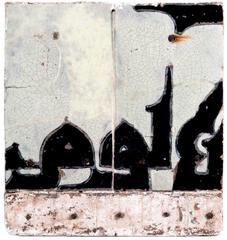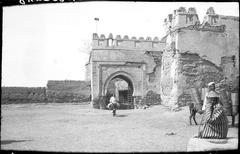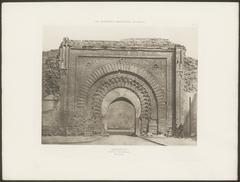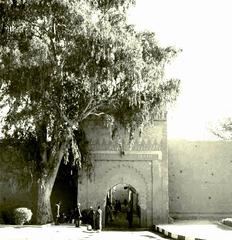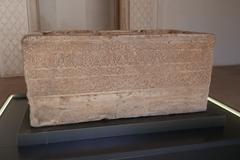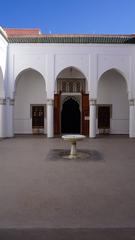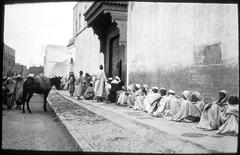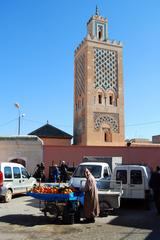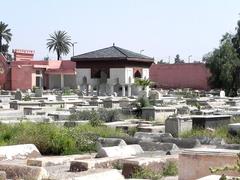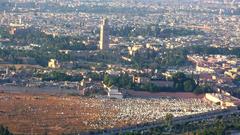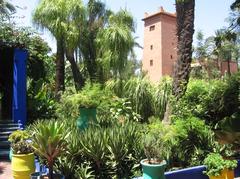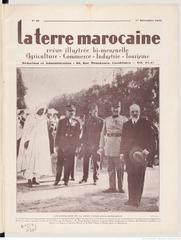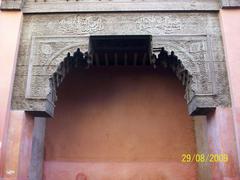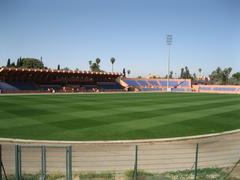Bab Nkob Visiting Hours, Tickets, and Travel Guide for Marrakesh’s Historic Gateway
Date: 14/06/2025
Introduction
Bab Nkob is a significant historical gateway in Marrakesh, seamlessly connecting the ancient medina with the modern district of Gueliz. As one of the most accessible and emblematic city gates, Bab Nkob offers visitors a unique perspective on Marrakesh’s layered history, resilient architecture, and lively urban culture. This comprehensive guide covers everything you need to know about Bab Nkob, including its historical context, architectural features, practical visitor information, nearby attractions, and essential travel tips.
Table of Contents
- Historical Overview
- Origins and Architecture
- Strategic and Urban Importance
- Visiting Hours, Tickets, and Accessibility
- Cultural and Symbolic Role
- Bab Nkob in Modern Marrakesh
- Visitor Tips
- Preservation and Future Outlook
- Frequently Asked Questions (FAQ)
- Visual and Media Resources
- Further Exploration
- Conclusion and Next Steps
Historical Overview
Founded in the late 11th century, Marrakesh quickly became a regional powerhouse under the Almoravid dynasty. Defensive city walls made from red tabia clay—giving Marrakesh its nickname, the “Red City”—were constructed by 1127 CE to protect the city and regulate its growth (Rough Guides). Bab Nkob, one of several gates punctuating these walls, has played a vital role in the city’s urban development for centuries.
City gates (“bab” in Arabic) like Bab Nkob controlled access, facilitated commerce, and served as defensive strongholds. Each gate reflected the needs of its era and the communities it served, evolving alongside Marrakesh’s urban and social landscape (Nomads Travel Guide).
Origins and Architecture
Bab Nkob, sometimes spelled Bab N’kob or Bab Enkob, is located at the southwestern edge of the medina, marking the transition to Gueliz. While the exact date of its original construction is not precisely documented, it likely dates to the 12th century, during the Almoravid or early Almohad period (Rough Guides).
The gate’s design is characterized by a robust, functional style, including an L-shaped, or “bent,” passage to impede invaders. Constructed from the same reddish tabia as the city walls, Bab Nkob blends seamlessly into the surrounding fortifications. Unlike the more ornate Bab Agnaou, Bab Nkob’s simplicity reflects its defensive function and military origins.
Strategic and Urban Importance
Bab Nkob’s strategic position at the junction of the historic medina and modern Gueliz has long made it a hub for commerce and cultural exchange. Historically, it was a primary entry point for traders and travelers from the south and west, including those from the Atlas Mountains and the Haouz plain (Traveler.ma).
Today, Bab Nkob serves as a practical landmark for navigation, linking the labyrinthine alleys of the medina to wide modern boulevards like Avenue Mohammed V. Its location makes it a favored starting point for tours and an essential artery for daily movement between the old and new city.
Visiting Hours, Tickets, and Accessibility
- Visiting Hours: Bab Nkob is open to the public 24/7.
- Tickets: Entry is free; no ticket is required.
- Guided Tours: Bab Nkob is included in many guided walking tours of Marrakesh, which can be booked online or locally.
- Accessibility: The immediate area is relatively accessible, with ramps and wide pavements, though the medina’s narrow, uneven streets may be challenging for those with mobility issues (Time Out Marrakech).
Cultural and Symbolic Role
Bab Nkob is more than a functional gateway; it is a marker of urban memory and identity. Its name is associated with the southern approach to the city and possibly with the nearby Nkob district or local tribes. The gate’s presence is woven into the daily rhythms, festivals, and processions of the city, acting as a threshold between the sacred and the secular, old and new (Tourist Secrets).
Bab Nkob in Modern Marrakesh
Opening onto Avenue Mohammed V, Bab Nkob is surrounded by a vibrant mix of shops, cafes, and hotels in Gueliz, while providing immediate access to the medina’s historic heart. Restoration efforts have maintained its historic appearance, and the gate continues to function as a crucial urban artery (Rough Guides).
Visitor Tips
- Orientation: Use Bab Nkob as a landmark for navigating between the medina and Gueliz. Carry a physical map or use a reliable travel app, as GPS may be unreliable in the medina (Traveler.ma).
- Photography: Late afternoon offers the best light for photos. Always ask before photographing people.
- Nearby Amenities: Cafes, ATMs, and public restrooms are available nearby, especially along Avenue Mohammed V.
- Safety: The area is generally safe, but remain vigilant for pickpockets in crowded spaces.
- Cultural Etiquette: Dress modestly and respect local customs, especially during religious holidays.
Preservation and Future Outlook
Marrakesh’s city walls and gates, including Bab Nkob, are part of a UNESCO World Heritage Site. Ongoing restoration projects ensure these historic structures are preserved for future generations, while balancing the needs of a growing modern city (Tourist Secrets).
Frequently Asked Questions (FAQ)
Q: What are Bab Nkob’s opening hours?
A: Bab Nkob is open 24 hours a day, with free access at all times.
Q: Is there an entry fee?
A: No, entry is free.
Q: Are guided tours available?
A: Yes, many medina tours include Bab Nkob.
Q: Is Bab Nkob accessible for people with disabilities?
A: The gate area is accessible, but the medina may be challenging for wheelchair users.
Q: What are the nearest attractions?
A: Jemaa el-Fnaa, Koutoubia Mosque, Saadian Tombs, and Gueliz are all nearby.
Visual and Media Resources
- Photos: Bab Nkob at sunrise/sunset, street scenes, and panoramic views from nearby rooftops.
- Maps: Interactive maps of Marrakesh’s medina highlighting Bab Nkob.
- Virtual Tours: Available on select travel apps and official tourism websites.
Further Exploration
Discover more with these related articles:
Conclusion and Next Steps
Bab Nkob is not only a gateway between Marrakesh’s past and present but also an enduring symbol of the city’s adaptability and rich cultural tapestry. Its free, 24-hour access and proximity to both historic and modern attractions make it an essential stop for every visitor. To deepen your experience, consider a guided tour, explore the medina’s bustling souks, or relax in a Gueliz café.
For the latest travel tips, offline maps, and exclusive insights, download the Audiala app. Stay connected through our social media and subscribe to our newsletter for updates on Marrakesh’s sites and cultural happenings.
References
- Rough Guides
- Nomads Travel Guide
- Time Out Marrakech
- The Broke Backpacker
- The Crazy Tourist
- Travel Morocco Today
- Voyage in Style
- Along Dusty Roads
- Bewildered in Morocco
- Attract Travel
- Tourist Secrets
